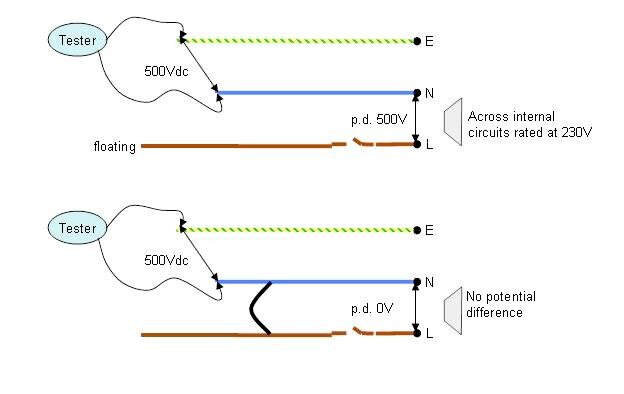- Mar 21, 2015
- 310
- 279
- 138
- If you're a qualified, trainee, or retired electrician - Which country is it that your work will be / is / was aimed at?
- United Kingdom
- What type of forum member are you?
- Practising Electrician (Qualified - Domestic or Commercial etc)
Hi all
I couldn't find any previous posts on this topic specifically so looking for some advice.
I am adding an external security light for a customer. I am extending the existing downstairs lighting circuit. Normally when testing Insulation Resistance I would test between L-N, L-E, N-E. This particular lighting circuit has thirty six downlights, fifteen of which are in a large extension with a ceiling that is up to 3.6m high. I've got a 2.1m A frame ladder that will enable me to get high enough to take the lamps out but I'm a bit warey of trying to disconnect the fittings without better equipment. As some LED fittings the fittings are also vulnerable to the L-E part of the test I'm concerned about doing it without removing them. Given that it is an existing circuit rather than a new installation can I just connect the live conductors and test between them and earth (as per 612.3.3)? My reading would be yes I can, but I'd be grateful for views from those with a bit more experience than me. Obviously I'll also test the cable I am putting in L-N, L-E, and N-E.
Thanks
I couldn't find any previous posts on this topic specifically so looking for some advice.
I am adding an external security light for a customer. I am extending the existing downstairs lighting circuit. Normally when testing Insulation Resistance I would test between L-N, L-E, N-E. This particular lighting circuit has thirty six downlights, fifteen of which are in a large extension with a ceiling that is up to 3.6m high. I've got a 2.1m A frame ladder that will enable me to get high enough to take the lamps out but I'm a bit warey of trying to disconnect the fittings without better equipment. As some LED fittings the fittings are also vulnerable to the L-E part of the test I'm concerned about doing it without removing them. Given that it is an existing circuit rather than a new installation can I just connect the live conductors and test between them and earth (as per 612.3.3)? My reading would be yes I can, but I'd be grateful for views from those with a bit more experience than me. Obviously I'll also test the cable I am putting in L-N, L-E, and N-E.
Thanks









